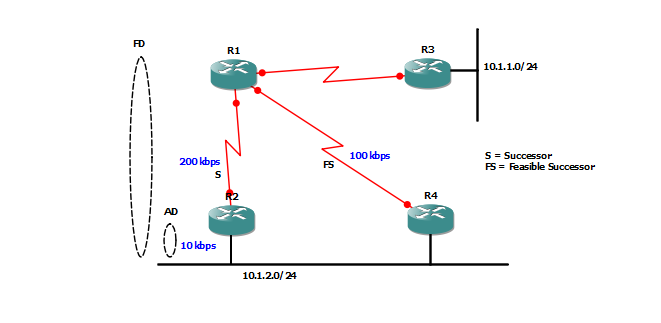EIGRP Routing Concepts and Planning
Preface
Enhanced Interior Gateway Routing Protocol (EIGRP) is an open routing protocol loosely based on their original IGRP created by Cisco. EIGRP is an advanced distance-vector routing protocol, with optimizations to minimize both the routing instability incurred after topology changes, as well as the use of bandwidth and processing power in the router. Routers that support EIGRP will automatically redistribute route information to IGRP neighbors by converting the 32 bit EIGRP metric to the 24 bit IGRP metric. Most of the routing optimizations are based on the Diffusing Update Algorithm (DUAL) work from SRI, which guarantees loop-free operation and provides a mechanism for fast convergence.
1 The Concepts
- 1.1 Why you would choose to use EIGRP
- 1.2 EIGRP Tables and Terminology
- 1.3 Visiting the friendly EIGRP Neighborhood
- 1.4 Visiting the not-so-friendly EIGRP metric calculation
1.1 Why you would choose to use EIGRP
- Backup routes (fast convergence / dual)
- Simple configuration
- Flexability in summarization
- Unequal cost load-balancing
- Combines best of distance vector and link state
1.2 EIGRP tables and terminology
A router running eigrp maintains three tables:
- Neighbor table
- Topology Table
- Routing Table
Feasible Distance
• Feasible distance is the minimum distance (metric) along a path to a destination network
Advertised Distance
• The metric reported by a neighbor. In our example 200kbps from the perspective of R1#
Successor
• The successor is your primary route
Feasible Successor
• The feasible successor is your backup route
Active Route
• active route means that a router sends a query message to find a new route. It’s a bad state
Passive Route
• Passive route means, that everything is o.k. No action in happening.
1.3 Visiting the friendly EIGRP Neighborhood
Hello: Form Relatinship
• the left router send a hello packet and the right router reply a hello message. Normally every 5 sec.
Update: sends updates
• the left router send the whole routing table to the right router. the right router acknowledge with the whole routing table, too.
Query: Asks about routes
• when a router lost a successor and have no feasible successor, the router sends a query messages to ask, who have a route to the destination network.
Reply: Response to a query
• The router can reply with a route that is o.k. But if the metric is to high, they can’t send an response to the router which ask for.
Ack: Acknowledges the update, query and reply messages
• self-explanatory
1.3 Understanding EIGRP metric calculation
- Bandwidth (K1)
- Delay (K3)
- Reliability (K4 and K5)
- Loading (K2)
MTUis not a part of calculation of bandwidth in EIGRP
-
Let’s calculate on the basis of an example
In most cases the Reliability and Loading will be put to Zero (0)
So – we can simplify our equation.
The Slowest_BW = 10^7 / 64kbps = 156250
All_Link_Delays = 2000 + 2000 + 2000 = 6000
Result is = 256 * (156250 + 6000) = 41536000






